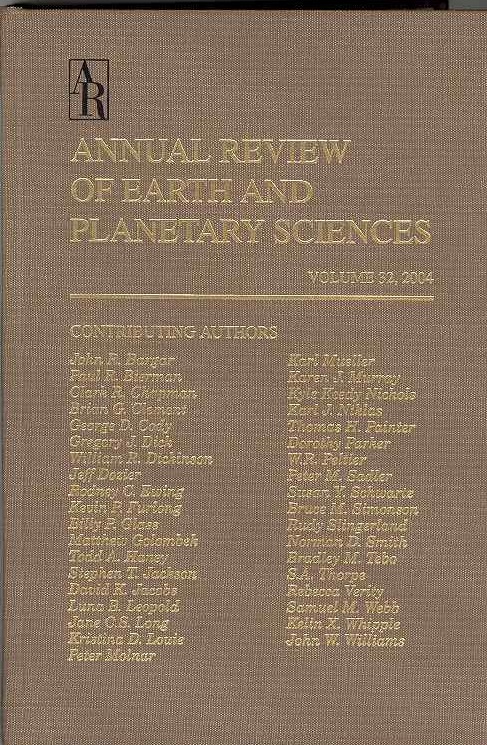卡西尼-惠更斯任务后土卫六的内部结构和动力学
IF 11.3
1区 地球科学
Q1 ASTRONOMY & ASTROPHYSICS
Annual Review of Earth and Planetary Sciences
Pub Date : 2021-05-30
DOI:10.1146/ANNUREV-EARTH-072920-052847
引用次数: 8
摘要
2004年至2017年期间,探索土星系统的卡西尼-惠更斯号任务彻底改变了我们对土卫六的理解。土卫六是已知的唯一一颗大气层稠密的卫星,也是除地球外唯一一颗表面有稳定液体的天体。它的大气中主要是氮气,也含有百分之几的甲烷,甲烷在很短的地质时间内被光分解,形成乙烷和更复杂的有机分子。大量甲烷和40Ar (40K的衰变产物)的存在,证明了从内部到表面的交换过程。这里我们回顾一下限制土卫六内部结构的信息。重力和轨道数据表明,土卫六是一个海洋世界,这意味着它分为水圈和岩石内核。由状态方程补充的质量和重力数据限制了海洋密度和组成以及水圈厚度。我们提出了端元模型,回顾了每一层的动力学,并讨论了与卡西尼-惠更斯数据一致的全球演化。▪土卫六是唯一一颗拥有稠密大气的卫星,有机分子可以在那里合成,并在表面沉积。■卡西尼-惠更斯号任务证明,土卫六是一个海洋世界,内部有水壳,两极有液态碳氢化合物海洋。▪水、岩石和有机物之间的相互作用可能发生在土卫六的大部分演化过程中,这具有很强的天体生物学意义。▪蜻蜓任务收集的数据以及与木星冰卫星探测器(JUICE)对木卫三的数据的比较将进一步揭示土卫六的天体生物学潜力。《地球与行星科学年度评论》第49卷的最终在线出版日期预计为2021年5月。修订后的估计数请参阅http://www.annualreviews.org/page/journal/pubdates。本文章由计算机程序翻译,如有差异,请以英文原文为准。
Titan's Interior Structure and Dynamics After the Cassini-Huygens Mission
The Cassini-Huygens mission that explored the Saturn system during the period 2004–2017 revolutionized our understanding of Titan, the only known moon with a dense atmosphere and the only body, besides Earth, with stable surface liquids. Its predominantly nitrogen atmosphere also contains a few percent of methane that is photolyzed on short geological timescales to form ethane and more complex organic molecules. The presence of a significant amount of methane and 40Ar, the decay product of 40K, argues for exchange processes from the interior to the surface. Here we review the information that constrains Titan's interior structure. Gravity and orbital data suggest that Titan is an ocean world, which implies differentiation into a hydrosphere and a rocky core. The mass and gravity data complemented by equations of state constrain the ocean density and composition as well as the hydrosphere thickness. We present end-member models, review the dynamics of each layer, and discuss the global evolution consistent with the Cassini-Huygens data. ▪ Titan is the only moon with a dense atmosphere where organic molecules are synthesized and have sedimented at the surface. ▪ The Cassini-Huygens mission demonstrated that Titan is an ocean world with an internal water shell and liquid hydrocarbon seas at the poles. ▪ Interactions between water, rock, and organics may have occurred during most of Titan's evolution, which has strong astrobiological implications. ▪ Data collected by the Dragonfly mission and comparison with the JUpiter ICy moons Explorer (JUICE) data for Ganymede will further reveal Titan's astrobiology potential. Expected final online publication date for the Annual Review of Earth and Planetary Sciences, Volume 49 is May 2021. Please see http://www.annualreviews.org/page/journal/pubdates for revised estimates.
求助全文
通过发布文献求助,成功后即可免费获取论文全文。
去求助
来源期刊

Annual Review of Earth and Planetary Sciences
地学天文-地球科学综合
CiteScore
25.10
自引率
0.00%
发文量
25
期刊介绍:
Since its establishment in 1973, the Annual Review of Earth and Planetary Sciences has been dedicated to providing comprehensive coverage of advancements in the field. This esteemed publication examines various aspects of earth and planetary sciences, encompassing climate, environment, geological hazards, planet formation, and the evolution of life. To ensure wider accessibility, the latest volume of the journal has transitioned from a gated model to open access through the Subscribe to Open program by Annual Reviews. Consequently, all articles published in this volume are now available under the Creative Commons Attribution (CC BY) license.
 求助内容:
求助内容: 应助结果提醒方式:
应助结果提醒方式:


